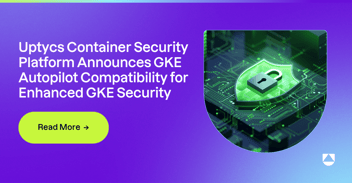As the pace of digital innovation is only matched by the complexity of the technologies that drive it, the question arises: Do you need a cloud-native application protection platform (CNAPP) to secure Kubernetes and containers?
The answer is becoming increasingly clear as organizations seek to navigate the labyrinth of modern application deployment securely. With Gartner projecting that by 2026, 80% of enterprises will have consolidated their security tooling down to three or fewer vendors from an average of 10 in 2022, the move toward a unified security approach is not just prudent—it's imperative.
Kubernetes and containers, while revolutionizing software delivery, introduce intricate security challenges that disparate tools are ill-equipped to address. A unified CNAPP solution, like the one offered by Uptycs, presents a compelling answer, cutting through the complexity to deliver clarity and robust security.
Understanding the security needs of Kubernetes and containers
Traditional security approaches, which are often siloed and static, are ill-equipped to handle the ephemeral nature of containers and the microservices architecture of Kubernetes. These environments require security that is as agile and scalable as they are—able to adapt to continuous changes, monitor traffic and activities between containers, and enforce policies in a decentralized way.
Moreover, containers can be susceptible to vulnerabilities at every stage of their lifecycle, from development to deployment. Without the proper tools, these vulnerabilities can go undetected and unaddressed, potentially leading to breaches. In contrast, a unified CNAPP solution is designed to provide continuous security, integrating with the development process and providing real-time visibility and protection for these dynamic environments.
Securing Kubernetes and containers isn't just about fending off attacks; it's about having a comprehensive view of the environment, understanding the interactions and dependencies, and being able to apply the right security controls at the right time. Traditional methods may lack the granularity and agility needed for such a task, leaving gaps that modern, sophisticated attackers are all too ready to exploit.
The key takeaway is this: As the way we build applications changes, so too must the way we secure them. Kubernetes and container security require a modern approach that matches the dynamic and distributed nature of the technology itself.
The fragmentation problem
Consider a real-world scenario: A financial services company uses one set of tools for scanning vulnerabilities in its container images, another for compliance monitoring, and yet another for runtime protection. This disjointed approach not only creates administrative headaches but also leads to significant security gaps. For example, a vulnerability detected during image scanning might be deemed low-risk in isolation, but when combined with a runtime misconfiguration, it could open the door to a serious breach.
From a business perspective, managing multiple security tools can be likened to juggling. Each tool requires specific expertise, individual licensing, separate support contracts, and distinct operational processes. This not only increases operational costs but also elongates the response time to threats. In the event of an attempted breach, time is of the essence, and navigating through a maze of tools to understand and mitigate the threat can be a daunting task.
Moreover, when security tools are siloed, they can't share intelligence or context, forcing analysts to switch contexts and lose critical minutes during their manual investigations. For instance, an alert from a network monitoring tool might seem innocuous until correlated with an unusual file access pattern detected by an endpoint security tool. But if these tools aren't communicating, the significance of these combined events could be missed entirely.
The implications of such inefficiencies are not just technical but also affect the broader business objectives. Security incidents can result in downtime, reputational damage, and regulatory penalties, all of which directly impact the bottom line. Therefore, it's not just about the effectiveness of security measures but also about the efficiency of their management and operation.
A unified approach: The power of CNAPP
Modern cloud security demands a model that's as integrated and dynamic as the environments it protects. This is where the concept of a Cloud-Native Application Protection Platform enters the picture. A CNAPP is a comprehensive security solution designed to address the full spectrum of cloud-native application risks, encompassing both the information and operations of the applications.
Uptycs embraces this approach, offering a seamless security fabric that extends from the developers' laptops where code is born, through the CI/CD pipeline where applications are assembled, to the cloud environments where they run. This level of integration ensures that every container, every service, and every process is accounted for and protected.
Maximizing ROI with Uptycs’ CNAPP
For businesses evaluating their security investments, ROI is a key consideration. Uptycs’ CNAPP transcends traditional security offerings, functioning as an enabler of business growth and efficiency. It simplifies security operations, integrating multiple functions into one platform, thereby reducing costs associated with tool sprawl and training. The automation within Uptycs' platform accelerates incident responses, allowing teams to allocate their time to higher-value tasks.
Procurement concerns such as cost, complexity, and value justification are directly addressed by Uptycs. A single subscription reduces the need for multiple licenses, and a unified console decreases operational complexity. Metrics provided by Uptycs demonstrate tangible improvements in security posture and compliance, which are vital for organizational success.
In essence, choosing a strong CNAPP solution is a strategic investment that aligns with the goals of agility, innovation, and growth. It offers not just protection but a competitive edge, ensuring businesses can defend their digital environments while enhancing operational effectiveness. For those steering the security decisions, choosing Uptycs is a step towards a more resilient and successful future.
Conclusion: Securing the future of Kubernetes and containers
The imperative for a unified security strategy in the Kubernetes and container ecosystem is undeniable. Faced with the title question, the industry's trajectory toward consolidation, and the insights from Gartner underscore the criticality of a CNAPP in today's security landscape.
The benefits of a CNAPP solution for Kubernetes and container security are clear: Integration over isolation reduces complexity, enhances security, and promotes efficiency. Uptycs provides the necessary tools to secure Kubernetes and containers without sacrificing the pace of innovation.







